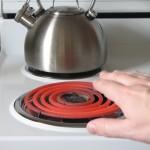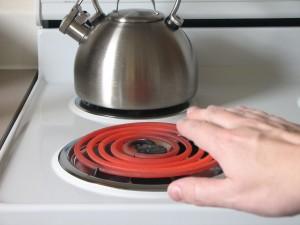

February 2-8, 2014 is National Burn Awareness Week in the US and we want to take this opportunity to raise awareness about what you can do to reduce burns and scalding burns around you.
We don't usually think of scalds and burns safety until an accident occurs. If you have children at your house, you probably think of it more often because they are a high-risk burn group. Older adults and people with disabilities are also likely to incur such injuries. Most scald burn happen in the home in connection with food preparation, serving of hot food or beverages or from exposure to hot tap water in bathtubs and showers.
- In 2003, an estimated 83,300 children ages 14 and under were treated in hospital emergency rooms for burn-related injuries
- 15,000 children are hospitalized annually with burn injuries
- 1,100 children die every year from fire and burns
Scald burns
- Approximately 21,000 children were treated for scald burns
- Among children ages 4 and under hospitalization for burn-related injures, an estimated 65% are treated for scald burns
- The total annual cost of scald burn-related deaths and injures among children ages 14 and under is $44 million. Children 4 and under account for more than 90 percent of these costs
Scald burns are most prevalent in the home and children make up a large percentage of those kinds of scald burns. This week, we will talk about other types of burns and give safety tips on reducing the risk of burns in your home and work place. Severe burns can also occur in the work place, typically when pipes and valves fail while carrying or regulating the flow of steam. We all need to work to reduce the number of scald burns in our homes and work places to protect those who may be more vulnerable to burns due to age or disability.
Temperature + Time on Skin=Severity of Scald Burn Injury
The severity of a scald injury depends on the temperature to which the skin is exposed and how long it is exposed. The most common regulatory standard for the maximum temperature of water delivered by residential water heater to tap is 120 degrees F/48 degrees C. At this temperature, the skin of adults requires an average of five minutes of exposure for a full thickness burn to occur. When the temperature of a hot liquid is increased to 140 degrees F/60 degrees C, it takes only five seconds or less for a serious burn to occur. Coffee, tea, hot chocolate and other hot beverages are usually served at 160-180 degrees F/ 71-80 degrees C, resulting in almost instantaneous burn that will require surgery. (Many chain restaurants have reduced the serving heat on hot liquids to decrease the risk of instantaneous burns to the skin)
High Risk Groups
Young Children- Young children have thinner skin resulting in deeper burns for the same exposure time and temperature to a scalding substance. The proportions of a child's body that is exposed to any given amount of scalding substance is also greater, the same cup of spilled coffee will burn a much larger percent of the child's body than an adults. Also, small children have little control of their environment, less perception of danger and less ability to escape a burning situation on their own. Children grow fast and can reach new and dangerous things everyday and they do not realize that liquids burn like fire.
Older Adults- Like young children, older adults have thinner skin so hot liquids cause deeper burns with even brief exposure. Their ability to feel heat may be decreased due to some medical conditions or medications so they may not realize water is too hot until the injury has occurred. Because they have poor microcirculation, heat is removed from burned tissue rather slowly compared ot younger adults. Older adults may also have conditions that make them more prone to falls in the bathtub or shower or while carrying hot liquids.
Individuals with Disabilities or Special Needs
Individuals who have physical, mental or emotional challenges or who require some kind of assistance from caregivers are also at high risk for all kinds of burns. The disability may permanent or temporary due to illness or injury and vary in severity from minor to total dependency on other people.
Mobility impairments, slow and awkward movements, muscle weakness or fatigue, or slower reflexes increase the risk of spills while moving hot liquids. Burns to the lap are common when a person attempts to carry hot liquids or food while seated in a wheelchair. Moving hot liquids can be extremely difficult for someone who uses a cane or a walker. Sensory impairments can result in decreased sensation and make it so a person does not realize the liquid is too hot. Changes in a person's intellect, perception, memory, judgment or awareness may hinder the person's ability to recognize dangerous situations or respond appropriately to remove themselves from danger
Other areas of burn-related injuries include electrical safety, fire/burn for older adults, leaving home safely, gasoline safety and summer burn safety.
Ameriburn.org is a great safety organization that has PowerPoint presentations for you to share at parent/caregiver groups and they give many helpful tips. Many of the tips seems like common sense, however, when we get busy with our daily lives, sometimes these small things get over looked.
If you have been the victim of a burn resulting from an accident that may have been caused by the negligence of another, then you may need a personal injury attorney. We have represented victims of burn injuries from car accidents, faulty warning systems (
product liability) and workplace burns. If you are not sure if you need an attorney, it never hurts to call and get information. Our attorneys are available seven days a week to discuss the facts of your case. Please call locally (314) 276-1681 or toll free (800) 685-3302

 February 2-8, 2014 is National Burn Awareness Week in the US and we want to take this opportunity to raise awareness about what you can do to reduce burns and scalding burns around you.
We don't usually think of scalds and burns safety until an accident occurs. If you have children at your house, you probably think of it more often because they are a high-risk burn group. Older adults and people with disabilities are also likely to incur such injuries. Most scald burn happen in the home in connection with food preparation, serving of hot food or beverages or from exposure to hot tap water in bathtubs and showers.
February 2-8, 2014 is National Burn Awareness Week in the US and we want to take this opportunity to raise awareness about what you can do to reduce burns and scalding burns around you.
We don't usually think of scalds and burns safety until an accident occurs. If you have children at your house, you probably think of it more often because they are a high-risk burn group. Older adults and people with disabilities are also likely to incur such injuries. Most scald burn happen in the home in connection with food preparation, serving of hot food or beverages or from exposure to hot tap water in bathtubs and showers.
